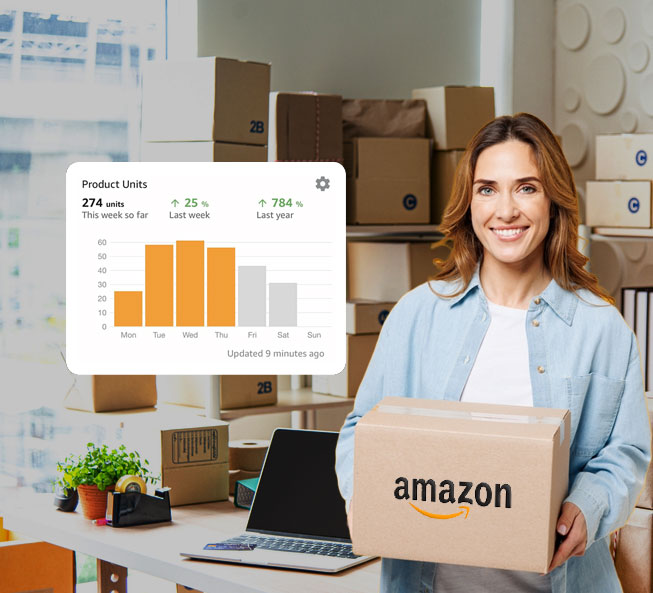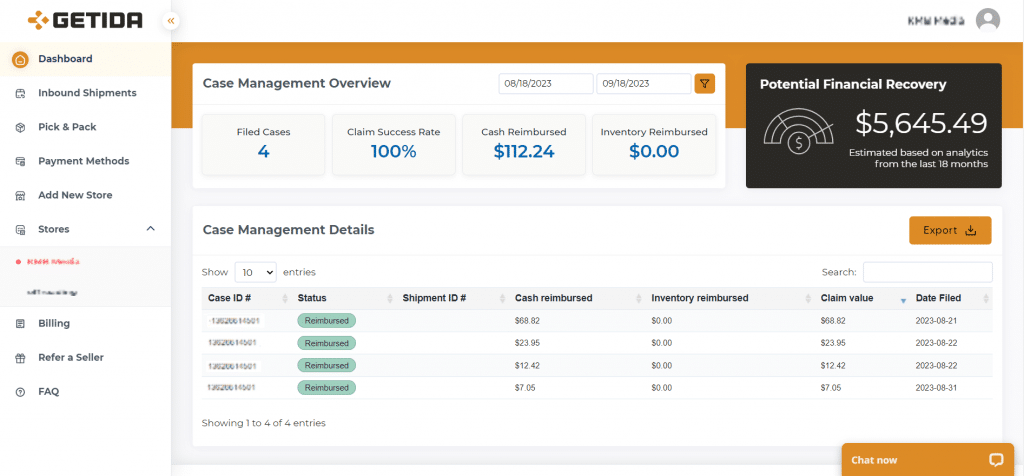Published on dealyouneed

Table of Contents
- Why Mistakes in FBA Still Cost Sellers Big Money
- Amazon’s Automated Reimbursements: A Step Forward—but Not Far Enough
- Real-Life Examples: Where Automation Falls Short
- The Cost of Ignoring These Gaps
- Enter Getida: Automation + Human Intelligence
- How Getida Works
- How Getida Outperforms Pure Automation
- Common Questions Sellers Ask About Getida
- Why Act Now?
- How to Start with Getida
- Final Thoughts
If you’re selling on Amazon in 2025, chances are you’ve heard the same mantra over and over:
“Automation fixes everything.”
We automate ads. We automate PPC bids. We automate inventory forecasting. We even automate pricing. And yes—Amazon automates some reimbursements.
But here’s the truth that’s costing Amazon sellers millions of dollars every year:
✅ Automation doesn’t catch everything.
In the world of Amazon FBA, mistakes happen constantly. Packages go missing. Inventory disappears. Customers get refunds and never return the product. Amazon measures a product’s size incorrectly and overcharges you fees for months.
And while Amazon’s automated systems do catch some of these issues, a staggering amount of money still slips through the cracks.
That’s where Getida comes in.
Getida blends automation with human intelligence to recover money Amazon owes you—money you’d almost certainly never see if you relied only on software bots.
In this deep dive, we’ll cover:
- Why errors in FBA remain a huge profit drain
- How Amazon’s automation works—and where it fails
- Real-life situations where automation simply can’t help
- How Getida’s human experts find hidden money
- Why sellers who rely only on automation lose out
- How to start recovering your cash with Getida
Let’s pull back the curtain on one of the biggest myths in e-commerce: that software alone can keep your Amazon business safe and profitable.
Why Mistakes in FBA Still Cost Sellers Big Money
Amazon’s FBA network is mind-blowingly vast:
- Over 175 fulfillment centers worldwide
- Millions of square feet of warehouse space
- Robots zooming around 24/7
- Millions of products moving every day
It’s a modern marvel. But it’s also a logistical powder keg.
And that means mistakes:
- A worker misplaces a box of your inventory.
- A return never makes it back into stock.
- An item is marked as lost during a warehouse transfer.
- A robot crushes your merchandise.
- Amazon measures your product’s box size incorrectly.
Individually, these issues might seem small. But multiplied across thousands—or millions—of units, the lost dollars become staggering.
Industry insiders estimate 1% to 3% of FBA inventory is affected by errors each year. For a seller doing $1 million in annual revenue, that’s $10,000 to $30,000 potentially slipping away annually.
Now, let’s get real:
👉 Automation helps.
But it doesn’t fix it all.
Amazon’s Automated Reimbursements: A Step Forward—but Not Far Enough

A few years ago, Amazon launched more sophisticated automated reimbursements. For certain issues—like lost inventory or damaged items—Amazon will proactively issue refunds without the seller filing a claim.
That’s great news. But it’s far from comprehensive.
Amazon’s automation misses tons of money sellers are owed.
Here’s why:
1. Automation Sees Only Simple Patterns
Amazon’s bots are rule-based. They check for:
- Items marked as lost
- Items marked as damaged
- Certain types of return errors
They’re good at “If A, then B” logic. But real-life logistics are messy. Many issues require:
- Reviewing multiple reports
- Connecting dots across several months
- Understanding how Amazon’s warehouse processes work
- Detecting subtle fee discrepancies
Automation simply isn’t sophisticated enough to handle these complex situations.
2. Timing Windows Create Gaps
Amazon often issues automated reimbursements—but if an error “resolves” itself later (e.g. lost inventory suddenly reappears), Amazon might reverse your reimbursement without fully compensating you.
For example:
- You’re reimbursed $500 for missing inventory.
- Amazon later “finds” the items and quietly reverses the reimbursement.
- You still lost money due to weeks (or months) of lost selling opportunity—but Amazon doesn’t automatically pay you for that lost sales window.
Automation doesn’t connect these dots. Humans have to spot this gap and claim the extra money you’re owed.
3. Automation Ignores Fee Errors
One of the biggest hidden costs for Amazon sellers is incorrect FBA fees. This happens when Amazon:
- Measures your product incorrectly (wrong dimensions)
- Weighs your item incorrectly
- Classifies your item as oversize instead of standard size
These errors can cause you to pay $1 to $10+ extra PER UNIT in fees.
Amazon’s system never automatically checks your product size or weight. It’s up to you to discover—and dispute—these errors.
4. Automation Misses Shipment Discrepancies
When you ship products to FBA, Amazon’s receiving process sometimes records fewer units than you shipped. For example:
- You ship 1,000 units.
- Amazon records only 970 received.
- 30 units are missing.
Amazon automation does not automatically reimburse you for this. You must:
- Cross-check shipping plans
- Pull carrier records
- Prove to Amazon that you shipped the full quantity
Most sellers never notice or don’t want to deal with the hassle.
5. Automation Doesn’t Handle Appeals
If Amazon denies a reimbursement claim, automation gives up.
Humans, however, know:
- How to phrase appeals
- Which policies to cite
- What documentation to provide
Appealing is often where sellers win the biggest reimbursements. Automation simply can’t handle this.
Real-Life Examples: Where Automation Falls Short

Let’s bring this home with real stories showing where automation simply isn’t enough.
Example 1: Overcharged Fees on Dimensions
A seller launched a kitchen utensil that should have been standard size. But Amazon’s system recorded it as oversize, resulting in:
- Correct FBA fee: $2.70 per unit
- Charged FBA fee: $4.95 per unit
The seller moved 12,000 units before noticing the error.
- Loss: $26,940
Amazon’s automation never flagged this. Only a human audit uncovered the overcharges. The seller filed for reimbursement and recovered nearly $27,000.
Example 2: Lost Inventory Found Too Late
A brand shipped 5,000 units of an accessory. Amazon recorded only 4,850.
Amazon’s automation didn’t reimburse automatically. A human audit discovered:
- Carrier documents proving 5,000 units shipped
- Warehouse discrepancies
- No record of the missing 150 units being received
After documentation and multiple appeals, the seller recovered the cost of the lost inventory.
Automation alone would have left $2,250 unclaimed.
Example 3: Unreturned Refunds
A customer ordered a $75 item and initiated a return. Amazon issued a refund but the item was never returned to the warehouse.
Automation didn’t detect the missing unit because the customer simply claimed the return was complete. A manual audit flagged the missing item, and the seller claimed reimbursement.
This error happens thousands of times a day across Amazon.
Example 4: Policy Misclassification
A seller’s product was classified incorrectly as hazardous, leading to:
- Extra fees
- Slower shipping
- Lost Buy Box opportunities
Automation didn’t identify the misclassification. A human audit spotted the error, leading to:
- Reclassification
- Refunds for overcharged fees
Automation missed $12,000 in unnecessary costs.
The Cost of Ignoring These Gaps
Here’s the reality:
✅ Even with automation, Amazon’s warehouse and logistics system is not perfect.
✅ Many errors never trigger automated refunds.
✅ Sellers who rely solely on automation leave huge money on the table.
The result?
- Lower profit margins
- Skewed financial data
- Lost cash flow
For Amazon sellers, that can be the difference between scaling a brand… or going out of business.
Enter Getida: Automation + Human Intelligence

This is why services like Getida exist.
Getida is not just software. They combine:
✅ Automated data scanning – Quickly detects suspicious discrepancies in your account.
✅ Human experts – Investigate issues, file claims, handle documentation, and fight appeals.
It’s the hybrid approach that purely automated tools can’t match.
How Getida Works
Here’s how Getida helps sellers recover money:
Step 1: Secure Account Connection
You securely connect your Amazon Seller Central account. Getida gains read-only access to your:
- Inventory reports
- Shipment data
- Fees reports
- Returns and adjustments
No changes are made to your listings or sales.
Step 2: Automated Data Scan
Getida’s software analyzes:
- Inventory discrepancies
- Lost units
- Inbound shipment shortfalls
- Customer returns not restocked
- Fee inconsistencies
The software identifies thousands of potential reimbursement opportunities.
Step 3: Human Review
Getida’s human analysts:
- Examine flagged discrepancies
- Check your documentation
- Identify valid claims
- Prepare evidence Amazon needs
This human intelligence is where Getida beats pure software solutions.
Step 4: Filing Claims
Getida’s team:
- Opens cases with Amazon
- Submits required documents
- Handles the back-and-forth with Seller Support
No time-consuming case management for you.
Step 5: Appeals & Escalations
If Amazon denies a claim:
- Getida’s team knows how to escalate.
- They reference Amazon’s policies.
- They craft appeals that get results.
Step 6: Reporting Results
You get clear reports showing:
- Reimbursements recovered
- Active cases
- Historical savings
It’s pure found money.
How Getida Outperforms Pure Automation
Let’s compare:
| Task | Automation-Only Tools | Getida |
|---|---|---|
| Detect lost inventory | ✅ | ✅ |
| Detect inbound shortfalls | ❌ | ✅ |
| File cases with Amazon | ❌ | ✅ |
| Handle appeals | ❌ | ✅ |
| Detect fee errors | ❌ | ✅ |
| Track complex adjustments | ❌ | ✅ |
| Monitor reversals of reimbursements | ❌ | ✅ |
Automation-only tools:
- Give you lists of possible issues.
- Expect YOU to handle cases, paperwork, and appeals.
Getida:
- Handles everything for you.
- Maximizes recovered money.
Common Questions Sellers Ask About Getida
Is Getida Safe?
Yes. Getida uses secure, read-only permissions. They cannot alter your listings, inventory, or financials.
How Does Getida Charge?
Getida charges a success-based fee. You pay only a percentage of recovered funds. No money recovered = no cost.
How Much Can Getida Recover?
It depends on your sales volume. Many sellers recover thousands to hundreds of thousands of dollars annually.
Does Amazon Allow This?
Absolutely. Sellers are entitled to file reimbursement claims. Amazon’s own documentation states sellers are responsible for monitoring inventory discrepancies.
Why Act Now?
Amazon continues to:
- Shorten the claims window (often down to 60-90 days)
- Implement cost-based reimbursements rather than sales-price-based refunds
Waiting costs you money. The sooner you audit, the more cash you recover.
How to Start with Getida

Ready to stop leaving money on the table?
Sign up at Getida here
- Free analysis of your account
- No upfront fees
- Pay only if money is recovered
It’s risk-free. And it could mean thousands of dollars back in your pocket.
Final Thoughts
Amazon sellers are bombarded with tools promising total automation. But the truth is: Getida bridges the gap with a smart hybrid approach—leveraging software and real human expertise.
Don’t let Amazon keep money that belongs to you. Your margins are too precious.
